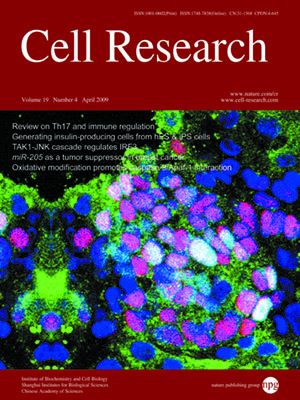
Volume 19, No 4, Apr 2009
ISSN: 1001-0602
EISSN: 1748-7838 2018
impact factor 17.848*
(Clarivate Analytics, 2019)
Volume 19 Issue 4, April 2009: 449-457
ORIGINAL ARTICLES
Oxidative modification of caspase-9 facilitates its activation via disulfide-mediated interaction with Apaf-1
Yong Zuo*, Binggang Xiang*, Jie Yang, Xuxu Sun, Yumei Wang, Hui Cang and Jing Yi
Department of Cell Biology, Key Laboratory of the Education Ministry for Cell Differentiation and Apoptosis, Institutes of Medical Sciences, Shanghai Jiao Tong University School of Medicine, Shanghai 200025, China
Correspondence: Jing Yi, Jie Yang,(yijing@shsmu.edu.cn; yangjieyj@126.com)
Intracellular reactive oxygen species (ROS) are known to regulate apoptosis. Activation of caspase-9, the initial caspase in the mitochondrial apoptotic cascade, is closely associated with ROS, but it is unclear whether ROS regulate caspase-9 via direct oxidative modification. The present study aims to elucidate the molecular mechanisms by which ROS mediate caspase-9 activation. Our results show that the cellular oxidative state facilitates caspase-9 activation. Hydrogen peroxide treatment causes the activation of caspase-9 and apoptosis, and promotes an interaction between caspase-9 and apoptotic protease-activating factor 1 (Apaf-1) via disulfide formation. In addition, in an
in vitro mitochondria-free system, the thiol-oxidant diamide promotes auto-cleavage of caspase-9 and the caspase-9/Apaf-1 interaction by facilitating the formation of disulfide-linked complexes. Finally, a point mutation at C403 of caspase-9 impairs both H
2O
2-promoted caspase-9 activation and interaction with Apaf-1 through the abolition of disulfide formation. The association between cytochrome
c and the C403S mutant is significantly weaker than that between cytochrome
c and wild-type caspase-9, indicating that oxidative modification of caspase-9 contributes to apoptosome formation under oxidative stress. Taken together, oxidative modification of caspase-9 by ROS can mediate its interaction with Apaf-1, and can thus promote its auto-cleavage and activation. This mechanism may facilitate apoptosome formation and caspase-9 activation under oxidative stress.
Cell Research (2009) 19:449-457. doi: 10.1038/cr.2009.19; published online 24 February 2009
FULL TEXT | PDF
Browse 1895


